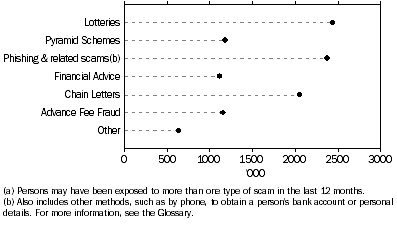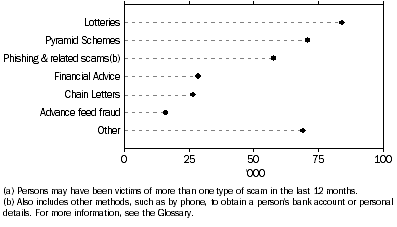VICTIMS OF SCAMS
INTRODUCTION
This chapter presents results for victims of a range of selected scams. Scams aim to elicit personal information and or obtain a financial benefit by deceptive means such as through an invitation, request, notification or offer. The Personal Fraud Survey included the following scams: lotteries, pyramid schemes, phishing and related scams, financial advice, chain letters, advance fee fraud and other. For more information about these scams refer to the Glossary.
EXPOSURE TO SCAMS
The Personal Fraud Survey collected information about people's exposure to scams. A person was deemed to have been exposed to a scam if they received, viewed and/or read an unsolicited invitation, request, notification or offer. In the twelve months prior to the survey, there were 5.8 million people exposed to a range of selected scams. Those aged 55 and over comprised 1.6 million of this total. Those earning a personal weekly income of less than $499 accounted for 1.9 million people exposed to scams, while those on a weekly income of $2,500 or more accounted for 208,000 people.
The three categories of selected scams with the highest number of people were: lotteries (2,437,400 people), phishing and related scams (2,374,700 people) and chain letters (2,054,000 people). Note a person may have been exposed to more than one type of scam during the survey period.
Exposure to selected scams(a)

VICTIMS OF SCAMS
There were 329,000 victims of all selected scams in Australia in the 12 months prior to interview, where a victim was defined as a person who responded to the scam by providing personal details and/or money or sought further information from the scammer. This represented a victimisation rate of 2%.
In the twelve months prior to the survey, people aged 35 to 44 years had a victimisation rate of 2.6% for all scam types, while those 55 and over had a rate of 1.6%. Those earning a personal weekly income of between $1,500 and $2,499 had a victimisation rate of 3.9%. The rate was lower for people earning a weekly personal income of less than $499 (1.6%).
Lotteries accounted for 84,100 victims (victimisation rate of 0.5%), pyramid schemes 70,900 victims (0.4%) and phishing and related scams 57,800 victims (0.4%). Note a person may have been a victim of more than one type of scam.
Victims of selected scams(a)

 Print Page
Print Page
 Print All
Print All